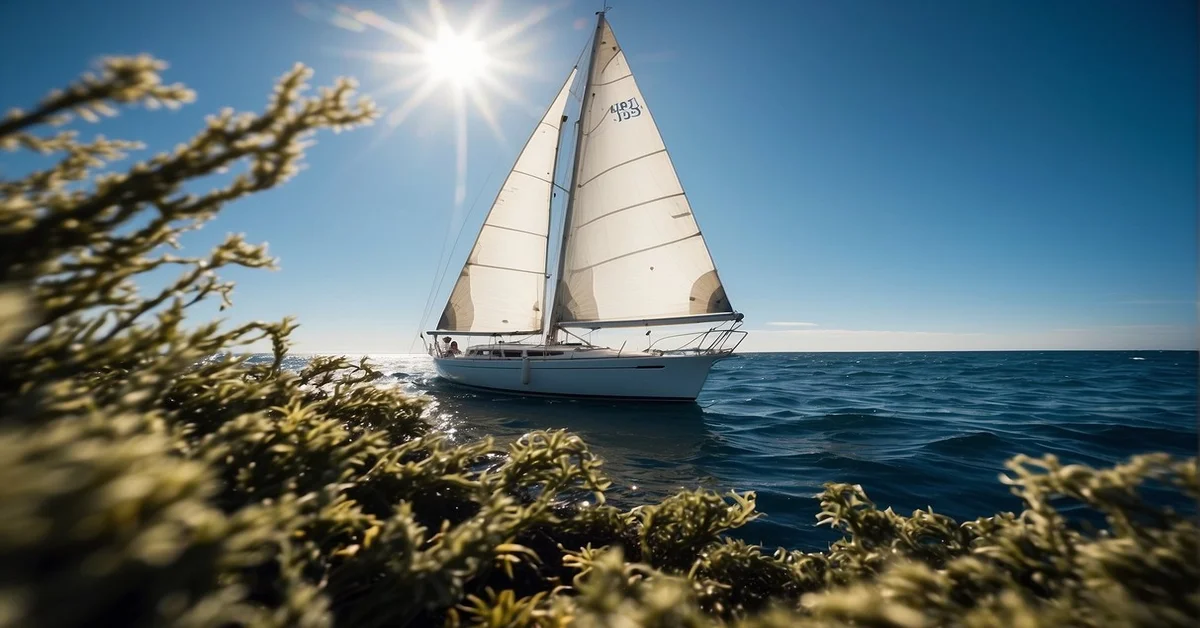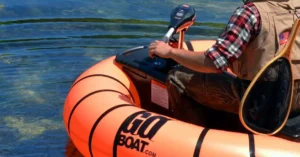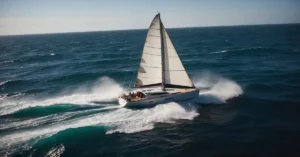Set sail on a voyage of imagination with A Sail Out of Seaweed. Could this be the eco-friendly future of sailing? Dive into the ocean’s bounty depths to discover if versatile seaweed can revolutionize our sails.
Prepare to be swept away by the tides of innovation in this exciting exploration of sustainability on the high seas!
A Sail Out of Seaweed – Only a Dream?
A sail out of seaweed is largely a product of imagination. While seaweed is abundant in some parts of the ocean and can entangle boats to some extent, the idea of a sail made entirely out of seaweed is more fanciful than real.
Seaweed has been used in various cultures for different purposes. Still, there is no widespread tradition or practical application of using seaweed to construct sails, which require materials with specific properties for strength, durability, and wind resistance.
The image of a sail made of seaweed might be compelling in a fictional or metaphorical sense, but it doesn’t reflect a practical reality.
In this article, we will examine this topic and its future Possibilities regarding this eco-friendly Evolution. Today, it’s not really a realistic Alternative.
Sailing on Seaweed: An Eco-Friendly Evolution

As we explore the potent potential of a Sail Out of Seaweed, I find that it’s not just a novel idea but a step forward in marine sustainability. This concept champions using renewable resources like kelp and various types of seaweed to create eco-friendly sails for boating.
Developing Seaweed Sails
Creating a seaweed sail involves weaving and sewing green, red, and brown seaweed strands. My research uncovers that alginate, a compound found in seaweed, enhances the durability of the fabricated sails. When scientists and sailmakers come together, they can harness these traits to craft sails that stand up to the rigors of the sea.
For instance, kelp—a type of brown seaweed—shows particular promise due to its strong fibrous structure. Scientists, sailmakers, and sailors collaborate to refine these techniques, working towards commercially viable seaweed-based sails.
Environmental Impacts
The environmental benefits of seaweed sails are substantial: they are biodegradable, thus creating less pollution. Seaweed is a renewable resource that absorbs carbon dioxide, aligning with efforts against climate change.
Additionally, because seaweed cultivation doesn’t require fertilizer or arable land, it avoids stressing terrestrial farming systems or coastal communities. Switching to seaweed sails could also reduce the impact on marine life, as traditional sails often end up as debris, affecting turtles, coral, and beaches.
Discussing the eco-friendly aspect, the sustainability of using seaweed as a material for sails is not to be taken lightly.
Seaweed Utility Beyond Sailing
My attention extends beyond sailing, as seaweed is used in various sectors. It’s a versatile material that supports commercial fishing with its availability and biodegradability. As algae-based products gain traction, seaweed is being transformed into alternatives for plastics and even serves as fertilizer, exhibiting its wide range of applications.
Exploring the history, I learned that Vikings used seaweed for their ships’ sails, which points to the long-standing recognition of seaweed’s utility.
Navigational Techniques and Considerations

When I first considered the notion of a sail out of seaweed, it struck me as a blend of the ancient mariner’s wisdom with a modern eco-conscious twist. Here, I’ll share insights on mastering the unique handling characteristics of seaweed sails and combining traditional seafaring skills with modern technology.
Mastering Seaweed Sail Handling
I’ve learned that the robustness of seaweed fibers can affect the overall handling of the sail. Seaweed sails can be more challenging due to their distinct properties than traditional sail materials like cotton or polyester. Here’s what to keep in mind:
- Durability: Seaweed is a renewable resource which suggests good sustainability, but its durability against the harsh marine environment is a concern.
- Tacking and Jibing: The maneuverability of a seaweed sail might differ, impacting how you tack or jibe when changing course.
Practical experience has taught me that while taking the helm with a seaweed sail, one should pay close attention to the sail’s response to wind and wave conditions, especially across the unpredictable waters of the Atlantic.
Traditional and Modern Integration
Incorporating seaweed sails into modern navigation requires balancing time-honored skills with contemporary tools:
- Algae and Marine Life: Using seaweed aligns with efforts to protect marine life and combat climate change due to its eco-friendly nature.
- Integration with Engine Power: Sails made from seaweed may need to work with engine power, especially when wind conditions are unfavorable.
I’ve found that an intimate understanding of seaweed sail properties is crucial when integrating them with rudder inputs and electronic navigation systems. This ensures that the vessel remains balanced and reliable during transit.
FAQ – Sail Out of Seaweed

Are you curious about crafting A Sail Out of Seaweed? Dive into our FAQ section, where we unravel the seaweed sail myth and give you the facts straight from the ocean’s surface!
What is washed-up seaweed called?
Sargassum is commonly found in the beach drift near Sargasum beds, where it is also known as gulfweed, a term that can also refer to all seaweed species washed up on shore.
Why is this seaweed called Sargasso?
It looked like a carpet of little yellow grapes, so they called it sargazo (a generic name in Spanish for brown seaweeds with an obvious stalk and root; the Sargasso Sea is “El mar de los Sargazos”). Sargassum is a brown algae, and the ‘grapes’ are the air bladders that keep it afloat.
What does seaweed do to the ocean?
Seaweed plays many vital roles in coastal ecosystems. Seaweed provides food and habitat for other marine species, cleans coastal waters by removing excess nutrients from runoff, and absorbs carbon dioxide from the water, protecting shelled animals (like oysters) from ocean acidification.
Cast your thoughts into the discussion below, and let us know if you believe A Sail Out of Seaweed could truly navigate the future of sustainable sailing!











